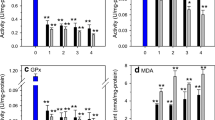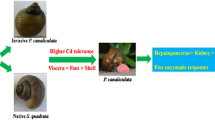Abstract
Individuals ofMurex trunculus from the Adriatic Sea were exposed to cadmium in the laboratory under chronic conditions (0.05 mg/L, up to 30 days). Cadmium contents in the soft parts of the snails increased considerably, the highest concentrations occurring in combined hepatopancreas + kidney tissues. However, high amounts of cadmium were also found in unexposed individuals. No significant changes were observed in the concentrations of zinc.
Cytosolic fractions of hepatopancreas + kidney organs were separated by gel and ion exchange chromatography. Variable amounts of cadmium were associated with components with a molecular weight of more than 75000 Daltons. Most of the metal, however, was bound to a protein with an apparent molecular weight of 11000 Daltons. This protein showed low absorption at 280 and a higher one at 254 nm. Amino acid composition revealed high amounts of cysteine (26%), lack of tyrosine, but presence of phenylalanine (4%). On the basis of these features, the protein was identified as a metallothionein-like protein.
With increasing time of exposure, cadmium replaced zinc from this protein, the latter metal moving towards fractions with a molecular weight of less than 3000 Daltons. Moreover, a “spillover” effect was observed:The cadmium content of the metallothionein-like protein increased up to a saturation point beyond which excess cadmium was bound to high molecular weight components.
Similar content being viewed by others
References
Axiak V, Schembri JL (1982) Effects of temperature on the toxicity of mercury and cadmium to the littoral gastropodMonodonta turbinata. Mar Pollut Bull 13:383–386
Bouquegneau JM, Martoja M, Truchet M (1983) Localisation biochimique du cadmium chez Murex trunculus L. (Prosobranche Neo-gasteropode) en milieu naturel non pollue et apres intoxication experimentale. CR Acad Sc Paris, 296 (III):1121–1124
Brady FO (1982) The physiological function of metallothionein. TIBS 7:143–145
Chin B, Lesowitz GS, Bernstein IA (1978) A cellular model for studying accommodation to environmental Stressors:Protection and potentiation by cadmium and other metals. Environ Res 16:432
Crisetig G, Carpene E, Cattani O, Serrazanetti GP (1983) Studio sulla distribuzione dei metalli pesanti inEngraulis encrasicholus L. alto e medio Adriatico. Nova Thalassia 6:395–406
Engel D, Brower M (1982) Detoxification of accumulated trace metals by the American oyster,Crassostrea virginica:laboratory vs environment. In Vernberg WB, Calabrese A, Thurberg FP and Vernberg FJ (eds), Physiological mechanisms of marine pollutant toxicity, pp 89–107
Fowler BA, Engel DW, Brouwer M (1986) Purification and characterization studies of cadmium-binding proteins from the American oyster,Crassostrea virginica. Environ Hlth Perspect 65:63–69
Frankenne F, Noel-Lambot F, Disteche A (1980) Isolation and characterization of metallothioneins from cadmium-loaded musselMytilus edulis. Comp Biochem Physiol 66C:179–182
Frazier JM, George SG (1983) Cadmium kinetics in oysters-a comparative study ofCrassostrea gigas andOstrea edulis. Mar Biol 76:55–61
Frazier JM, George SS, Overnell J, Coombs TL, Kägi J (1985) Characterization of two molecular weight classes of cadmium binding proteins from the mussel,Mytilus edulis. Comp Biochem Physiol 80C:257–262
Funk AE, Day FA, Brady FO (1987) Displacement of zinc and copper from copper-induced metallothionein by cadmium and by mercury:invivo andex vivo studies. Comp Biochem Physiol 86C:1–6
George SG, Carpene E, Coombs TL, Overnell J, Youngson A (1979) Characterization of cadmium-binding proteins from mussel,Mytilus edulis (L.), exposed to cadmium. Biochim Biophys Acta 580:225–233
Hamer DH (1986) Metallothionein. Ann Rev Biochem 55:913–951
Hemelraad J, Kleinveld HA, de Roos AM, Holwerda DA, Zandee DI (1987) Cadmium kinetics in freshwater clams. III. Effects of zinc on uptake and distribution of cadmium inAnodonta cygnea. Arch Environ Contam Toxicol 16:95–101
Hirs CHW (1967) Determination of cysteine as cysteic acid. In: Hirs CHW (ed) Methods in Enzymology, Vol. 11, Academic Press, New York, pp 59–65
Hutcheson M, Miller DC, White AQ (1985) Respiratory and behavioral responses of the grass shrimpPalaemonetes pugio to cadmium and reduced dissolved oxygen. Mar Biol 88:59–66
Jackim E, Morrison G, Steele R (1977) Effects of environmental factors on radiocadmium uptake by four species of marine bivalves. Mar Biol 40:303–308
Kägi JHR, Vallee BL (1960) Metallothionein:A cadmium- and zinc-containing protein from equine renal cortex II. J Biol Chem 235:2435–2442
Kägi JHR, Vasak M, Lerch K, Gilg DEO, Hunziker P, Bernhard WR, Good M (1984) Structure of mammalian metallothionein. Environ Hlth Perspect 54:93–103
Kosta L, Ravnik V, Byrne AR, Stirn J, Dermelj M, Stegnar P (1978) Some trace elements in the waters, marine organisms and sediments of the Adriatic by neutron activation analysis. J Radioanal Chem 44:317–332
Langston WJ, Zhou M (1986) Evaluation of the significance of metal-binding proteins in the gastropodLittorina littorea. Mar Biol 92:505–515
Margoshes M, Vallee BL (1957) A cadmium binding protein from equine kidney cortex. J Am Chem Soc 79:4813–4814
Moore S, Stein WH (1951) Chromatography of amino acids on sulfonated polystyrene resins. J Biol Chem 192:663–681
Moretti G, Zuzzi L, Pellizzato M (1979) L' inquinamento marino e lagunare-1. Metalli pesanti. Lavori Soc Ven Sc Nat 4:6–19
— (1980) Indagine sull' inquinamento da metalli pesanti nei mitili della laguna di Venezia. Acqua-Aria 8:1013–1016
Nemer M, Wilinson DG, Travaglini EC, Sternberg EJ, Butt TR (1985) Sea urchin metallothionein sequence:Key to an evolutionary diversity. Proc Natl Acad Sci USA 82:4992–4994
Noel-Lambot F, Bouquegneau JM, Frankenne F, Disteche A (1980) Cadmium, zinc and copper accumulation in limpets (Patella vulgata) from the Bristol channel with special reference to metallothioneins. Mar Ecol Progr Ser 2:81–89
Nordberg GF, Nordberg M, Piscator M, Vesterberg O (1972) Separation of two forms of rabbit metallothionein by isoelectric focusing. Biochem J 126:491–498
Olafson RW, Sim RG, Boto KG (1979) Isolation and chemical characterization of the heavy metal-binding protein metallothionein from marine invertebrates. Comp Biochem Physiol 626:407–416
Olafson RW, Thompson JAJ (1974) Isolation of heavy metal binding proteins from marine vertebrates. Mar Biol 28:83–86
Roesijadi G (1980) The significance of low molecular weight, metallothionein-like proteins in marine invertebrates: Current status. Mar Environ Res 4:167–179
Spackman DH, Stein WH, Moore S (1958) Automatic recording apparatus for use in the chromatography of amino acids. Anal Chem 30:1190–1206
Stone HC, Overnell J (1985) Non-metallothionein cadmium binding proteins-Minireview. Comp Biochem Physiol 80C:9–14
Stone HC, Wilson SB, Overneli J (1986) Cadmium binding components of scallop (Pecten maximus) digestive gland. Partial purification and characterization. Comp Biochem Physiol 85C:259–268
Webb M (1972) Protection by zinc against toxicity. Biochem Pharmacol 21:2767–2771
Author information
Authors and Affiliations
Rights and permissions
About this article
Cite this article
Dallinger, R., Carpenè, E., Via, G.J.D. et al. Effects of cadmium onMurex trunculus from the Adriatic Sea. I. Accumulation of metal and binding to a metallothionein-like protein. Arch. Environ. Contam. Toxicol. 18, 554–561 (1989). https://doi.org/10.1007/BF01055022
Received:
Revised:
Issue Date:
DOI: https://doi.org/10.1007/BF01055022




